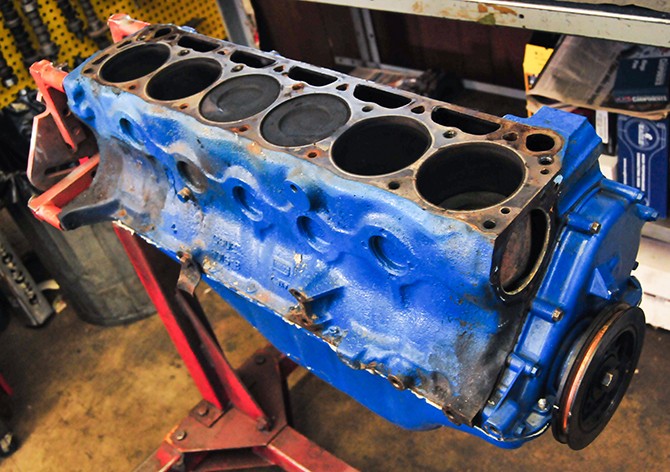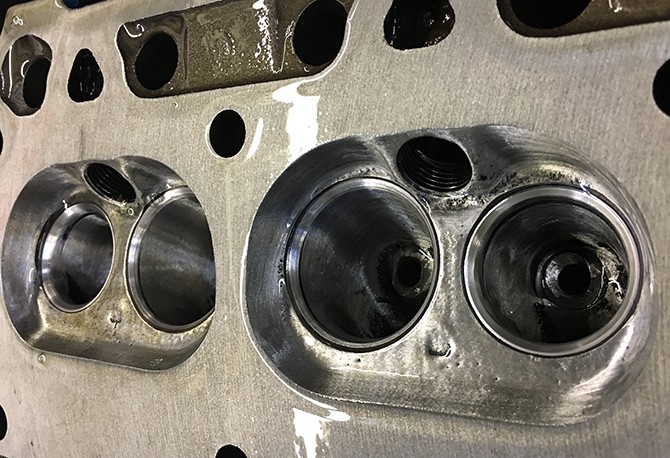Part 1 of the Vintage Mustang Project detailed 1966 Mustang owner John’s decision to rebuild the tired 200 cubic-inch inline 6 that powered his convertible for over 50 years. The engine and transmission were removed and taken to Victory Engines, where owner Ray Banyas and his brother Paul could refresh the engine and transmission, respectively.

John and Ray made a plan for a standard teardown and rebuild – John didn’t want to try to turn his Mustang into a hotrod. Because you never know what you’re going to find when you tear into an engine, the first step was to tear down the engine and inspect everything. Keeping in mind that John was driving the Mustang and opted to do this rebuild as a preventative refresh rather than as a necessity due to failure, what Ray found came as a surprise!
When the cylinder head was removed, it was very obvious that someone had been in this engine before. The sealing surfaces had some signs of improper prep work and a replacement head gasket was installed.

Speaking of the head gasket, the head gasket had been burned out between cylinders 2 and 3, which was the result of gouges in the sealing surfaces due to improper cleaning. But why was the head gasket replaced before John got the car?
A quick glance at the pistons tells us why. The cylinder 3 piston was intact but damaged - at some point, there was something in the cylinder which damaged the top of the piston.

All of the cylinder walls were showing 50 years of wear with ridges at the top where the pistons do not travel, especially cylinder 1. This is because cylinder 1 runs the coolest and therefore expands the least, resulting in tighter piston-to-wall clearance.

Some bearing wear was present, along with wear on the crankshaft and camshaft. However, considering the engine had been run for 50+ years and countless miles, this was to be expected. When the crank was removed Ray found the bearings were original – this bottom end had been together for over 50 years!

Even with all of this, Ray determined that both the head and block could be reconditioned, so he got to work! The block was decked to create a flat, smooth sealing surface and remove the previous pitting and gouging. This also resulted in a slight bump in compression. The cylinders had to be bored .060˝ to remove the lips and cylinder wall scoring. The journals were line-honed to ensure perfect alignment and the crankshaft was balance tested – and found to still be in balance!

The cylinder head was milled to create a flat and smooth sealing surface to match the block, also slightly raising compression. The vintage 200cid inline 6 incorporated a “log-head” design where the intake manifold is integrated into the cylinder head in an effort to save money on the then-economical 6 cylinder. As Banyas is a race engine builder at heart, so after talking things over with John, he also did some light porting to the head and intake manifold to improve flow and add a bit of power.

As mentioned, John wasn’t looking to squeeze every bit of power out of the old inline-6, but he also doesn’t mind a bit extra passing power to help the car move out of its’ own way while out cruising around. With the projected power that would result from the additional cubic inches gained from the larger pistons, porting of the heads, and increased compression ratio to 9.5:1, John and Ray decided the stock, super-economy focused Autolite 1100 single barrel carburetor was not going to get the job done. After researching possible solutions, they decided on a Weber 38 Outlaw synchronous 2-barrel carb.
But going that route entailed some serious modifications to log intake manifold. Ray had to route it out, and in the process also honed, ported and smoothed out the intake manifold passage. An adapter plate was then bolted to the manifold that would accommodate the larger carb.

After the engine and cylinder head reconditioning was complete, it was time to order new gaskets and engine components. John told us this was honestly the easiest part of all! You see, Fel-Pro and Sealed Power have the industry’s largest selection of vintage engine parts. In addition to the complete gasket sets from Fel-Pro, Sealed Power engine parts for the inline 6 include the needed .060 over pistons and rings (you can get .080 if needed), as well as all the other necessary engine parts including a new cam, rockers, valves, hydraulic lifters, oil pump, freeze plugs and premium, high tech aluminum alloy bearings. Due to the material removed from the head and block during machining, slightly shorter pushrods were required – a quick search in the Sealed Power catalog led them to the part number for shorter pushrods which were in stock along with the rest of the parts required for this vintage engine.
On a separate note, while Sealed Power offers the stock replacement valve springs for the inline 6, Banyas went with a higher rate spring from the Ford 302 to accommodate the increased power and higher redline that engine will now have.

Stay tuned for Part 3 where John gets the engine back in the car and gets the Mustang out on the road once again!